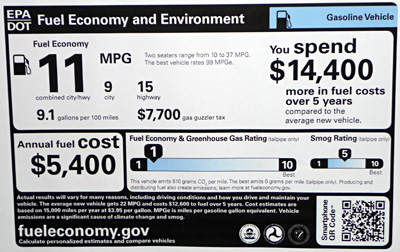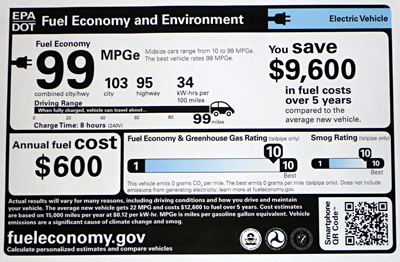New Car Labels Emphasize Emissions and Savings

Buy a gas guzzler and you might discover a new form of “sticker shock.”
Cars and trucks sitting on dealership lots will soon have a new fuel economy sticker in the window. Today, the Environmental Protection Agency released newly-designed labels that emphasize environmental performance for conventional and electric cars.
The label might seem familiar to California drivers. In 2008, the state released its own environmental impact sticker for new cars. It rates a car’s smog and greenhouse gas emissions on a scale of one to ten.
The new national label follows California’s lead and incorporates the same rating system. But for the first time, it will also display the annual fuel cost for a vehicle, comparing it to an average vehicle over five years.
EPA regional administrator Jared Blumenfeld announced the new labels in the Silicon Valley showroom of electric car maker Tesla. He says as plug-in hybrid and electric cars started appearing on the market, it became clear that the old sticker wouldn’t cut it. “This label really allows a consumer to compare a gasoline vehicle to an electric vehicle for the first time.”
Blumenfeld says he expects the labels to make a difference in areas populated by early adopters of EVs. “Los Angeles and San Francisco are in the top three of hybrid purchases in the nation. People are already starting to buy these alternative vehicles in large numbers.”
Since electric cars don’t use gas, their energy use is displayed in “miles per gallon equivalent”, which the government calculates by assuming a gallon of gasoline is equal to 33.7 kilowatt-hours of electricity.
For Tesla’s Roadster sports car, that pencils out to 119 miles per “gallon” and a $9,900 fuel savings over five years, compared to an average car.

Of course, when it comes to greenhouse gas emissions, electric cars are only as clean as the electricity they use. Electric cars in coal states are responsible for more emissions than in states that generate a lot of renewable power.
To estimate greenhouse gas emissions, the EPA took an average of the energy source mix across the country. But in a press conference, EPA Administrator Lisa Jackson emphasized a new tool that consumers could use to “drill down” to their part of the country.
Crunch some numbers and the differences are pretty stark. A Nissan Leaf that’s charged in San Francisco produces 120 grams of CO2 per mile, according to the calculator. That same Nissan Leaf in Indianapolis, Indiana generates 270 grams of CO2 per mile.
One more number to note: in the US, consumers are accustomed to seeing miles per gallon. For the first time, the new labels also include gallons per 100 miles. Research has shown that “gallons per mile” is a much easier to understand when it comes to fuel economy.
One example: You might assume the difference between a 40-mpg and 30-mpg car is about the same as the difference between 30-and-20-mpg. Flip those numbers around to gallons used per 10,000 miles and the picture becomes a little clearer. A 40-mpg ride saves 83 gallons over one that gets 30 mpg. But the difference between 30-and 20-mpg is 167 gallons.
The new stickers will appear on model-year 2013 cars and trucks.

